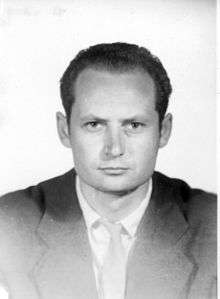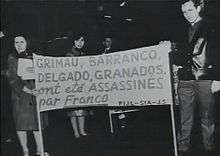Manuel Moreno Barranco
| Manuel Moreno Barranco | |
|---|---|
 Manuel Moreno Barranco | |
| Born |
24 April 1932 Jerez de la Frontera, Spain |
| Died |
22 February 1963 Jerez de la Frontera, Spain |
| Occupation | Writer |
| Language | Spanish |
| Nationality | Spanish |
Manuel Moreno Barranco (24 April 1932-22 February 1963) was a Spanish writer, whose extensive work includes short tales, novellas and novels, and was interrupted at the age of 30, by his violent death at the prison of Jerez in 1963,[1] which has never been investigated.
Life
Barranco was born on 24 April 1932, at Jerez de la Frontera. His father's name was Manuel, and his mother's María Luisa. In August 1932 his father, prosecuted by the Falangists, fled his home and went to the republican zone: some days later, news came that group of republicans which included his father had been shot down at the mountains of Ronda while crossing the nearby of Ronda on its way to Malaga.
Barranco studied commerce and started working at the bank of Jerez when he was sixteen years old. Keen on the adventure romance genre at the time, he collected novels like those of Emilio Salgari or El Coyote. In 1950 he was diagnosed with tuberculosis and forced to withdraw for more than a year. During this long sojourn he began his first literary efforts. Manuel Moreno then wrote some short stories and a novella, and he sent them to Editorial Aguilar in 1955. They would eventually get published in 1957 under the title Revelations of a Castaway.
In October 1956, encouraged by the coming edition of his book, Barranco asked for holiday time at the bank of Jerez and went to Madrid, looking for a new work in the capital to develop his literary career, which was a very difficult pursuit to accomplish in his hometown.[2] He managed to get a job at the Popular Bank of Spain. It is in Madrid that he began his novel Happy Arcadia and resumed writing short stories. His work "Revelations of a Castaway" is finally published in 1957, meriting praise from various critics.[3]
In February 1959 he was granted leave at the bank and went to London, where he worked as an associate editor in the Embassy of Venezuela for six months. In September he travelled to Switzerland and Italy and in October he finally arrived in Paris. After a period of poverty and manual labour, he got a job at the Agricultural Bank of France and made friends among the Spanish community in exile. He finished editing his novel Happy Arcade and Juan Goytisolo recommended that he publish it in Mexico. He began his second novel, Bank Clerks, which remained unfinished, but his main concern was the edition of the first one. In spite of his many administrations to get this done in Mexico, where the publication was announced,[4] he was unsuccessful. In those Parisian years he maintained a romance with Suzanne Lacoste, with whom he had wedding plans. In October 1962 he holidayed in Barcelona for 15 days, where he was told by some friend about a six-month course in Carlos Barral's publishing house. Excited by this proposal, he settled in Molins de Rei and resigned from the Agricultural Bank of France by letter. He allegedly spent two months attempting to get inscribed in the aforementioned course; disillusioned and moneyless, he returned to Jerez on 24 November 1962.
Barranco spent Christmas in his family house, and got back in touch with his friends in Jerez. As one of them recalls:
since his return to Jerez we often met and we talk much, you could feel in conversation that he was a communist, he didn't say it, but he didn't deny it either. You mustn't bring malicious gossip over yourself back then. In those days Grimau was arrested and half dead since he had been pushed in front of a window located in the General Security Department, just to wind up executed by shooting. Francoist information services were aware of this affiliation and he was under surveillance since he crossed the border.[5]
On 27 January 1963 the police entered the family house looking for a pirate radio. They didn't find anything and left. Worried about the surveillance he was under, he hid his writing machine and his last writings in a friend's house. This friend testifies:
he started writing political pamphlets he carefully handed out. One of those writings fell into the hands of the police. He realizes this prosecution and the sole thing he thought they could use to prove he was responsible for them was his writing machine, which he brought together with some writings to my house in order to hide them. At the end of January they entered his house and didn't found anything, but they had to prove that the writings were his. I was going to get married in a few days, it seems that all his friend were watched. Javier Bellido, a common friend, took the writings and hid them in the vaults of the church of San Dionisio, his brother Luis being there the priest, the machine stood here.[6]
The indicated writings were lost because they ended up in a hideout in the church vaults,[7] which were demolished some years later.
On 13 February 1963 the police entered the family house once again and arrested Barranco. There is no confirmed judiciary mandate, nor was he charged with any formal accusation. Lawyers asked by the family to take the case refused by claiming that it's a "matter of jurisdictional competence". While he was in jail, some police officers visited his mother, threatening her.[8] On the tenth day after his arrest, his sister was informed that he had "thrown himself from the prison balustrade", resulting in serious injury. He was admitted to the hospital of Santa Ana, where he would die at 17:00 that same day. Local newspaper Ayer reported the next day that Barranco had fallen from the balustrade, without any mention of his incarceration, thereby spreading the same official version offered three months later by the government with regard to Julián Grimau: suicide. The then Tourism and Information Minister, Manuel Fraga Iribarne defended this version in a letter to José Manuel Caballero Bonald, who had signed a manifesto requesting the authorities to investigate the incident.
When the warder opened, as usual, the cell occupied by mister Moreno Barranco, at eight in the morning of February 22nd, the recluse jumped head first from the balustrade of the corridor located in front of his cell and fell to the yard, the base of his crane being broken.[9]
The other prisoners reportedly did not witness the suicide. The only witness was the police in charge of the interrogation, who would tell a friend of Barranco's some years later that he had been there to inform Barranco about his transfer to Madrid.[10] The case shows many similarities with the defenestration of Julian Grimau,[11] as well as with the four police defenestrations suffered by inmates registered between 1963 and 1969, none of which were admitted by the authorities.[12] Barranco suffered a cerebral haemorrhage. The police prevented his mother from seeing her dying son and presided over his burial,[13] to which his own friends refused to go for fear of getting involved.[14]
Legacy

There were many echoes in different parts of the world about the unclear circumstances that surrounded his death, as much in clandestine media within the Spanish border [15] as in the exile. [16] In France a committee called "Union of Writers on Behalf of the Truth" was formed to cast light on the facts. [17] Important media in France, [18] England, [19] Mexico [20] and the United States published the event and demanded an explanation. Pablo Neruda read about it in the Chilean press, [21] and the case is cited in books and university papers [22] of the Anglosphere, [23] as well as in the French [24] the Spanish exile worlds. [25] This international interest wasn't of any use when it came to force the Francoist regime to carry out an investigation. Hence, the case hasn't found, as others of its kind, any elucidation up to the present day.
Bibliography
Short stories
- "Encrucijada" (1955) ("Revelaciones de un náufrago", Editorial Aguilar, Madrid, 1957)
- "Amanecer" (1955) ("Revelaciones de un náufrago", Editorial Aguilar, Madrid, 1957)
- "Sin cuartel" (1955) ("Revelaciones de un náufrago", Editorial Aguilar, Madrid, 1957)
- "Un marido viejo" (1955) (""Revelaciones de un náufrago", Editorial Aguilar, Madrid, 1957)
- "El engaño" (1955) ("Revelaciones de un náufrago", Editorial Aguilar, Madrid, 1957)
- "La muerta" (1956) (unpublished)
- "¡Late, late,corazón de desierto!" (1956) (unpublished)
- "La fuerza del muerto" (1958) (unpublished)
- "El cuarto de baño" (1958) (unpublished)
- "El miedo" (1958) (unpublished)
- "Carta a un amigo" (1958) (unpublished)
- "Paraíso negro" (1958) (unpublished)
- "La navegación de Julián" (1958)(unpublished)
- "Una dama de provincias"(1958)(unpublished)
- "En la marisma" (1958) (unpublished)
- "Un empleado de banca" (1958) (unpublished)
- "El constructor de jaulas" (1958)(unpublished)
- "El viejo y Jehová" (1959) (unpublished)
- "El señor Coronel" (1959) (unpublished)
Novellas
- Retratos y Paisajes de Carmelo Vargas (1955), Revelaciones de un náufrago, Editorial Aguilar, Madrid, 1957
- La llamada (1956) (unpublished)
Novels
- Arcadia Feliz (1960), new digital edition, Editorial Torre de Viento, 2013.
- Bancarios (1961) (unfinished novel)
Diary
- Diario de viaje a las minas de Riotinto (1961) (unpublished)
References
- ↑ Revelaciones de un defenestrado Diario de Jerez 22 February 2013.
- ↑ Lettre sur l'asphyxie culturelle de Jerez-1956
- ↑ L’un de ceux qui commencent, critique, 1957 España Semanal 1957.
- ↑ Arcadia feliz, anunciada en México,1961 .
- ↑ Testimonio de su amigo Jesús González
- ↑ Ocultación de los últimos escritos en la Iglesia de San Dionisio
- ↑ Las antiguas bóvedas de la Iglesia, que ya no existen
- ↑ Amenazas policiales a la madre de Manuel Moreno
- ↑ Carta de Manuel Fraga Iribarne a José Manuel Caballero Bonald
- ↑ El policía que sí estaba allí
- ↑ Tortura y defenestración de Julián Grimau
- ↑ Cuatro defenestraciones policiales
- ↑ La policía impide a la madre ver al hijo agonizante
- ↑ Los amigos no fueron al entierro
- ↑ / "Boletín clandestino Unidad- Jerez, february 1964
- ↑ Boletín de la Oficina de Prensa de Euzkadi en el exilio, 1 april 1963
- ↑ News in Le Figaro, 22 june 1963
- ↑ News in L´Express, 16 may 1963
- ↑ News in The Guardian,23 october 1963
- ↑ News in Comunidad Ibérica, México,1963
- ↑ Prologue of Pablo Neruda, 14 june 1963
- ↑ Hispanic American report, Stanford University, vol 16-1963
- ↑ Prologue en The spanish conspirators
- ↑ Hommage à un martyr", par Liberto Villacampa, à propos de Manuel Moreno Barranco, "Espoir" du 6/9/63
- ↑ De las cortes de Cádiz al Plan de Desarrollo, 1808-1966-París Ruedo Ibérico, 1968